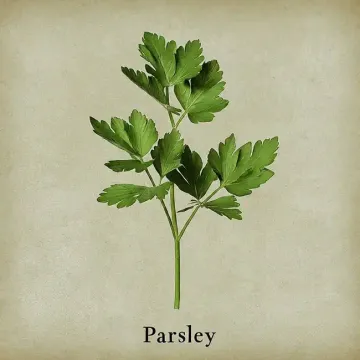Parsley (Petroselinum crispum) is a popular and versatile herb that has been cherished for centuries for its culinary and medicinal properties. Whether you're a seasoned gardener or just starting out, parsley is an excellent addition to any home garden. Its bright green leaves and fresh, slightly peppery flavor make it a favorite in kitchens around the world.
History of Parsley
Parsley has a long and storied history that dates back to ancient times. Native to the central Mediterranean region, parsley was first cultivated in Sardinia, Italy. It was used by the ancient Greeks and Romans not only as a culinary herb but also in religious ceremonies and as a symbol of victory and death. In Greek mythology, parsley was associated with the hero Archemorus, and the plant was often used to adorn graves.
During the Middle Ages, parsley became a common ingredient in European cuisine and was used for medicinal purposes. It eventually spread to the Americas, where it was cultivated by early settlers. Today, parsley is grown worldwide and remains a staple in kitchens and gardens alike.
Health Benefits of Parsley
Parsley is more than just a garnish; it is packed with nutrients and offers several health benefits:
- Rich in Vitamins and Minerals: Parsley is an excellent source of vitamins A, C, and K, as well as folate and iron. These nutrients are essential for maintaining healthy vision, boosting the immune system, and supporting bone health.
- Antioxidant Properties: Parsley contains flavonoids, such as apigenin, which have antioxidant properties that help protect cells from damage caused by free radicals.
- Supports Digestive Health: Parsley has been traditionally used to aid digestion and relieve bloating. It contains compounds that can help reduce gas and improve overall digestion.
- Anti-Inflammatory Effects: The high levels of vitamin C and other antioxidants in parsley contribute to its anti-inflammatory properties, which can help reduce the risk of chronic diseases such as heart disease and arthritis.
Culinary Uses of Parsley
Parsley is a versatile herb that can be used in a variety of culinary applications:
- Garnish: Fresh parsley is commonly used as a garnish to add color and a burst of flavor to dishes such as soups, stews, and salads.
- Salads: Parsley is a key ingredient in Middle Eastern dishes like tabbouleh, where it is used as the main component along with bulgur wheat, tomatoes, and lemon juice.
- Herb Butters and Sauces: Parsley can be blended with butter, garlic, and lemon juice to create a flavorful herb butter, or mixed into sauces such as chimichurri or gremolata.
- Soups and Stews: Chopped parsley is often added to soups and stews towards the end of cooking to enhance the flavor and provide a fresh, green element to the dish.
- Seasoning: Dried parsley can be used as a seasoning in a variety of recipes, including pasta dishes, marinades, and dressings.
Growing Tips for Parsley
Parsley is relatively easy to grow, making it a great choice for home gardeners. Here are some tips to help you successfully grow parsley in your garden:
- Choosing a Location: Parsley thrives in well-drained soil with plenty of organic matter. It prefers full sun but can tolerate partial shade, especially in hotter climates.
- Planting: Parsley can be grown from seeds or transplants. If starting from seed, soak the seeds in warm water for 24 hours before planting to improve germination. Sow seeds about 1/4 inch deep and thin seedlings to about 6-8 inches apart.
- Watering: Keep the soil consistently moist, but not waterlogged. Parsley has shallow roots, so regular watering is important, especially during dry periods.
- Fertilizing: Parsley benefits from regular feeding with a balanced fertilizer. If you're using organic compost, mix it into the soil before planting to provide essential nutrients.
- Harvesting: You can begin harvesting parsley once the leaves are large enough to use. Cut the outer leaves first, allowing the inner leaves to continue growing. Regular harvesting will encourage the plant to produce more leaves.
- Pests and Diseases: Parsley is generally pest-resistant, but it can be affected by aphids, spider mites, and leaf miners. Regular inspection and using organic pest control methods can help keep your plants healthy.
- Overwintering: In colder climates, parsley can be grown as an annual, but it may survive the winter with protection. Mulching around the base of the plants can help insulate the roots.
Conclusion
Parsley is a valuable addition to any home garden, offering both culinary delights and health benefits. With its rich history, nutritional value, and versatility in the kitchen, parsley is a herb that deserves a place in your garden. By following these growing tips, you'll be able to enjoy fresh parsley year-round, adding flavor and color to your meals.

